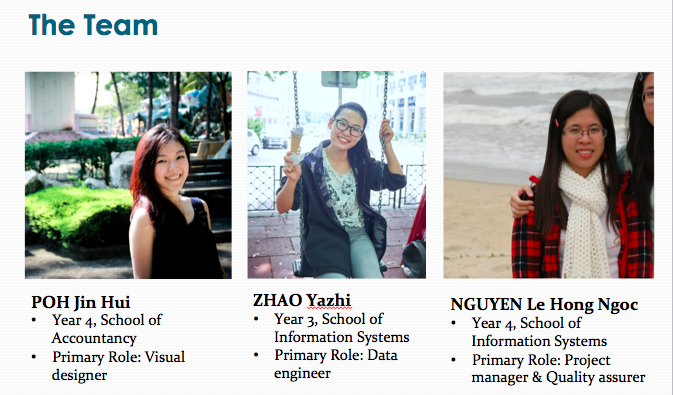Difference between revisions of "T15 Team"
Yzzhao.2013 (talk | contribs) |
Yzzhao.2013 (talk | contribs) |
||
| (3 intermediate revisions by the same user not shown) | |||
| Line 16: | Line 16: | ||
| style="padding:0.3em; font-size:100%; background-color:#e5e5e5; border-bottom:0px solid #3D9DD7; text-align:center; color:#1a2155" width="12%" | | | style="padding:0.3em; font-size:100%; background-color:#e5e5e5; border-bottom:0px solid #3D9DD7; text-align:center; color:#1a2155" width="12%" | | ||
[[T15_Overview |<font face = "Palatino Linotype" color="#1a2155" size=2><b>PROJECT OVERVIEW</b></font>]] | [[T15_Overview |<font face = "Palatino Linotype" color="#1a2155" size=2><b>PROJECT OVERVIEW</b></font>]] | ||
| + | |||
| + | | style="border-bottom:0px solid #3D9DD7; background:none;" width="1%" | | ||
| + | | style="padding:0.3em; font-size:100%; background-color:#e5e5e5; border-bottom:0px solid #3D9DD7; text-align:center; color:#1a2155" width="10%" | | ||
| + | [[T15_Final_Delivery| <font face = "Palatino Linotype" color="#1a2155" size=2><b>FINAL DELIVERY</b></font>]] | ||
| style="border-bottom:0px solid #3D9DD7; background:none;" width="1%" | | | style="border-bottom:0px solid #3D9DD7; background:none;" width="1%" | | ||
| Line 26: | Line 30: | ||
|} | |} | ||
| + | |||
</center><br> | </center><br> | ||
| + | ==<div style="background: #E0E0E0; padding: 15px; font-weight: bold; line-height: 0.3em; text-indent: 15px; font-size: 18px; font-family=helvetica"><font color=#000000>Team Introduction</font></div>== | ||
<center> [[File:The_team.png| 700px|]] </center> | <center> [[File:The_team.png| 700px|]] </center> | ||
| + | ==<div style="background: #E0E0E0; padding: 15px; font-weight: bold; line-height: 0.3em; text-indent: 15px; font-size: 18px; font-family=helvetica"><font color=#000000>Company Introduction</font></div>== | ||
| + | <p> | ||
| + | The Programme for International Student Assessment (PISA) is a international survey which aims to evaluate education systems worldwide by testing the skills and knowledge of 15-year-old students. To date, students representing more than 70 economies have participated in the assessment. The most recently published results are from the assessment in 2012. </p> | ||
| + | <p> | ||
| + | Around 510,000 students in 65 economies took part in the PISA 2012 assessment of reading, mathematics and science representing about 28 million 15-year-olds globally. Given PISA is an ongoing triennial survey, countries and economies participating in successive surveys can compare their students' performance over time and assess the impact of education policy decisions.</p> | ||
| + | <p>Since the year 2000, every three years, fifteen-year-old students from randomly selected schools worldwide take tests in the key subjects: reading, mathematics and science, with a focus on one subject in each year of assessment. Students take a test that lasts 2 hours. The tests are a mixture of open-ended and multiple-choice questions that are organized in groups based on a passage setting out a real-life situation. A total of about 390 minutes of test items are covered. Students take different combinations of different tests. The students and their school principals also answer questionnaires to provide information about the students' backgrounds, schools and learning experiences and about the broader school system and learning environment.</p> | ||
Latest revision as of 11:14, 14 April 2016
Team Introduction

Company Introduction
The Programme for International Student Assessment (PISA) is a international survey which aims to evaluate education systems worldwide by testing the skills and knowledge of 15-year-old students. To date, students representing more than 70 economies have participated in the assessment. The most recently published results are from the assessment in 2012.
Around 510,000 students in 65 economies took part in the PISA 2012 assessment of reading, mathematics and science representing about 28 million 15-year-olds globally. Given PISA is an ongoing triennial survey, countries and economies participating in successive surveys can compare their students' performance over time and assess the impact of education policy decisions.
Since the year 2000, every three years, fifteen-year-old students from randomly selected schools worldwide take tests in the key subjects: reading, mathematics and science, with a focus on one subject in each year of assessment. Students take a test that lasts 2 hours. The tests are a mixture of open-ended and multiple-choice questions that are organized in groups based on a passage setting out a real-life situation. A total of about 390 minutes of test items are covered. Students take different combinations of different tests. The students and their school principals also answer questionnaires to provide information about the students' backgrounds, schools and learning experiences and about the broader school system and learning environment.
